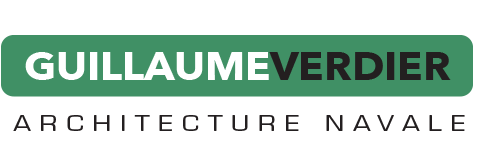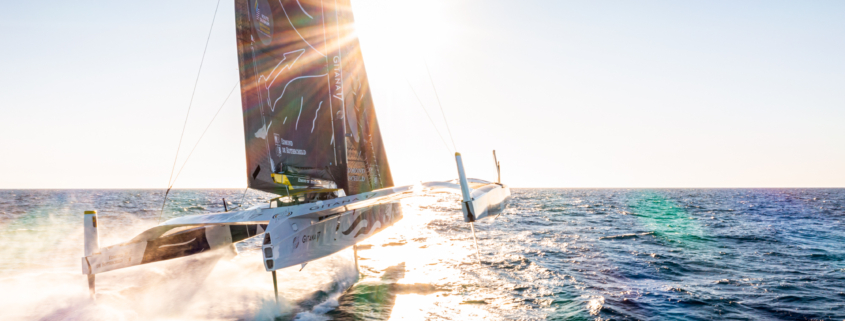INTERVIEW. Guillaume Verdier: “I like to be able to be critical, without being too annoying”.
Emirates Team New Zealand, Imoca Macif, Maxi Edmond de Rothschild… They all bear the signature of Guillaume Verdier. The naval architect, formerly with Finot-Conq and VPLP, looks back on his exciting career and discusses his vision of racing boats in the second episode of our interview with Guillaume Verdier.
Voiles et Voiliers: What do you see as the major turning points in naval architecture?
Guillaume Verdier: There’s less uncertainty because we use more simulation software. When I arrived, it was the very beginning of computer design. Foils were invented a long time ago, the physics were there, but it required a huge investment. You could say that investment in architecture has been overdeveloped. We sell many more hours of work, and we have tools that help us understand the physics balances. If we compare the Before and after Excel, there has been an abrupt change. All the calculation software is available, and knowledge is hyper-accessible. Access to science isn’t the same as it was in the 80s. Before those years, people would go off in a corner and leave out part of the boat, so it was hard to show that it was a really good idea. Someone could make a great wing mast, but the hull would be rubbish, or a great foil, but without anything to drive it forward, no sail plan.
Voiles et Voiliers: Your boats are always on the podium. Why is that?
Guillaume Verdier: They may be different boats, but there’s competition and that’s going to change. There are a lot of young people coming up.
Voiles et Voiliers: You’re not aiming to win?
Guillaume Verdier: Yes, of course, if there are customers who come to see us, it’s because they feel they have a better chance of winning. Or maybe it’s because they think we’re nice… We try to make sure there’s a good understanding when we do projects. We have some very demanding clients, like Charlie Dalin, who is also an architect. It’s easier to work with someone who knows what they’re talking about. If we’re lucky enough to have good clients, it’s easier to win.
You also avoid messy projects.
Voiles et Voiliers: Don’t you think there’s a bit of modesty there?
Guillaume Verdier: No, it’s a bit of a positive spiral. It’s also a way of avoiding messy projects or working with certain people with whom I know things won’t go well. You can’t do a good project with someone you don’t like. There’s tension. There’s a fear of who’s going to take what responsibility. If people don’t understand the risk and are too procedural, it’s hard to fulfill a contract that holds up. We take risks. It’s not like buying a car from a dealer.
Voiles et Voiliers: Do you think you take more risks than some of your competitors?
Guillaume Verdier: No, I think we’re taking fewer and fewer. You have to know how to take risks. There are some you shouldn’t take and others where you know you can push a little. For example, a foil that’s too thin will break; if it’s too thick, it won’t move forward. If strength is a design criterion, then it becomes more dangerous, and you have to assess the safety factor. For example, we’d be tempted to make a very thin keel, especially for boats sailing in Saint-Tropez, which don’t face rough seas. But regulations prevent this, and fortunately so, because we’d be tempted to do some pretty crazy things.
I like to put my nose into the hull, the structural calculations, to know how to do everything so I can be critical without being too boring.
Voiles et Voiliers: What is your vision of architecture?
Guillaume Verdier: I always try to turn the pancake upside down. When you’re going down a certain road, I try to step back and see if there’s another solution that’s been tried before. In fact, I’m probably not a very good project manager, but I like to dig into the hull, the structural calculations, knowing everything so I can be critical without being too boring.
Voiles et Voiliers: You spent a lot of time in New Zealand. Do you think this has helped you in your profession?
Guillaume Verdier: Yes, Team New Zealand’s methods are interesting, with horizontal work and the sailors taking part. Ray Davies sometimes helps us on projects to understand how a boat works. It’s complicated to understand how a boat works in terms of mechanics and electronics. Sometimes we only draw the hull and foils, but to understand how everything works together, it’s good to get feedback from the people on board.
Voiles et Voiliers: When you’re not designing a boat or parts, you’re also on a boat?
Guillaume Verdier: I sail quite a bit here, in the Gulf of Morbihan or in Greece with Giovanni Soldini. But I also like nature, so I go for walks and work in the garden.
Voiles et Voiliers: Does nature inspire you?
Guillaume Verdier: That’s why I do it, why I live here in Brittany and why I love being in New Zealand.
Voiles et Voiliers: Looking back, what was your favorite project to work on?
Guillaume Verdier: I loved doing Safran 1 for Marc Guillemot because it was my first boat with a high-tech sponsor. They trusted me and the boat worked well. Maxi Edmond de Rothschild was a project I liked, but it was a very risky boat. Flying a boat isn’t very hard, but flying a boat of this size in heavy seas, I found a bit risky from an architectural point of view. Now it can fly in 3 or 4 meters of swell. Another project I enjoyed working on was the San Francisco Cup with Team New Zealand. It was a meeting of lots of people with quite a different course. To relaunch the Cup with the Kiwis, Nick Holroyd, who was coordinator of the design team at the time, called on people from the aeronautics industry in the United States, fluid specialists from the army, Australians with Glenn Ashby, Italians… a whole range of nationalities, each with their own specialities. There were incredible discussions, something that rarely happens.
Voiles et Voiliers: We’re always trying to go faster with our boats. Can we continue to do so in today’s world, or are we reaching the limits of the exercise?
Guillaume Verdier: I don’t think we’re at the limits of the exercise. Is there any point in doing it? I’m not sure. The technique is interesting. Having engineers working on mechatronics allows us to move forward in many areas, but everyone is moving forward at the same time. We sometimes work with people from the automotive industry, and they have the same knowledge as we do. They’re the same engineers, so the mix is growing. We have a bit of a specialty with cavitation and marine physics, but a good aeronautical engineer can be a good naval architect, I think. After that, is it interesting to go faster? Not really, there’s not much point. If it’s not taken as a game, there’s no point. And if the game leads to a sharing of knowledge to advance knowledge and show people that without carbon, without oil, we can go 225 km/h or circumnavigate the world in 42 days, that won’t be bad.


